RSR ORCA Turbo Dash
RSR ORCA Turbo Dash
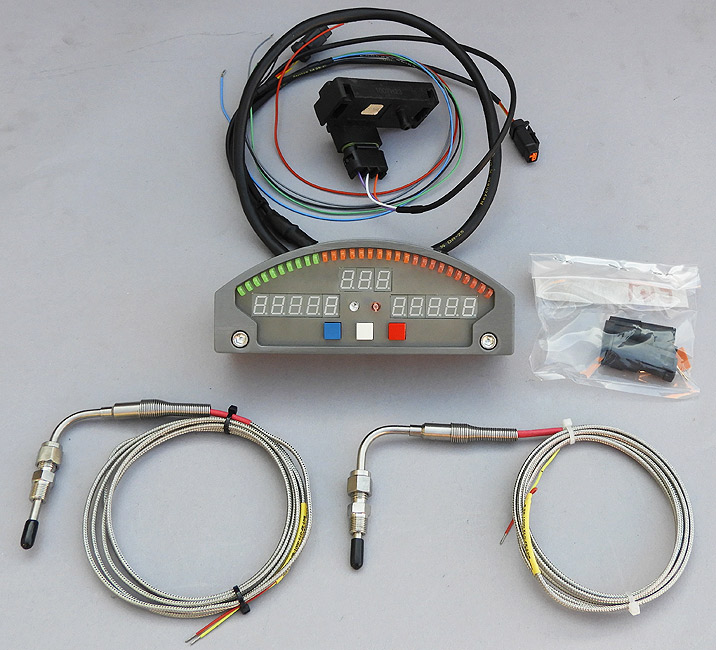
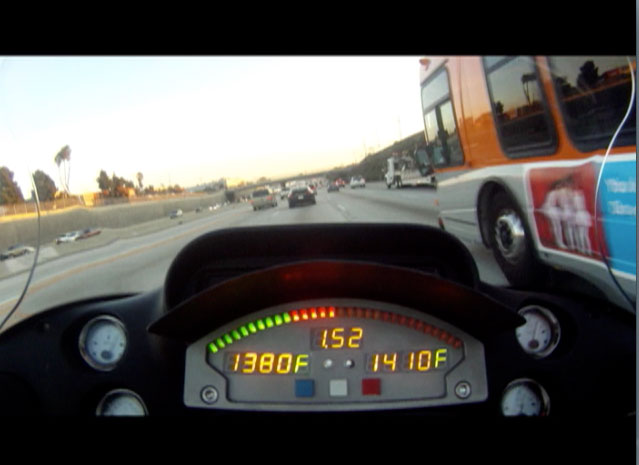
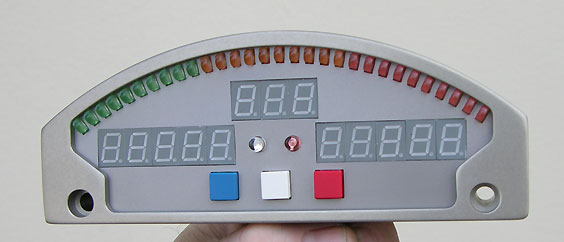
Dual EGT gauges, Celsius or Fahrenheit switchable, and a 3 Bar (30 In Hg to 30 PSI) boost gauge with two 12VDc event warning lights, typically H2O activation and low oil pressure, all in a 6.5" x 2.5" billet enclosure.
Development History
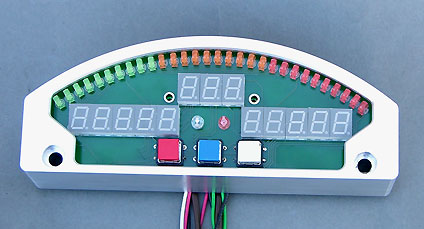
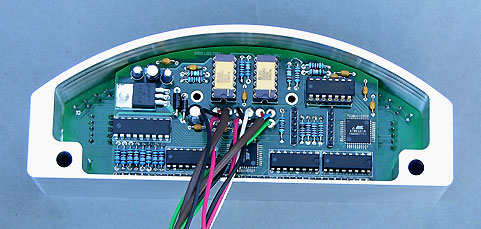
Machined billet enclosure and microprocessor based electronics. Probably 100 starts over a very long period before we went from paper, breadboard testing and computer studies before we actually made production circuit boards, purchased tooling and started cutting metal. Then it gets expensive.
Born in Competition
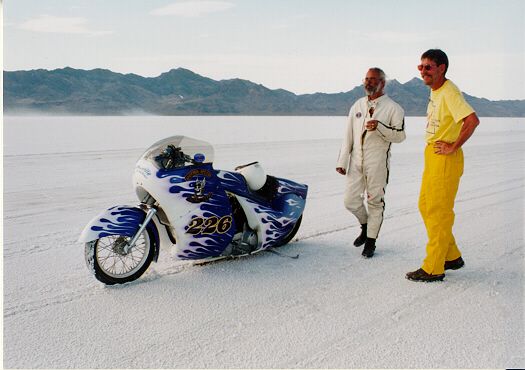
After 28 years of turbochargers, 35 years racing in all sorts of places, legal or not, we pretty much got fed up with the lousy selection of exhaust gas temperature and boost gauges. At one time we had nearly 100 failed boost gauges in a big box. Needles that fell off. Glycerin filled gauges that leaked. Gauges that would not "zero". Gauges that you could not see at night. Gauges that were killed by vibration and you name it...they were all killed sooner or later by something.
Darwin was right.
Same goes for EGT gauges. We pretty much gave up on them after putting several thousand dollars worth of analog and digital gauges in the trash. They were plagued by poor design, unreliability, and in some cases, so many wires, amplifier boxes and clunky displays that they simply were not mountable. Vibration broke needles off or they simply were erratic. Displays you could not read that had cryptic scales.
Ditto!
We finally came to the conclusion it was time to take what we had learned and make something that was useful and something that we would be proud of. In the end you have to please yourself or it just is not worth going through all the development and expense. All you have to do is "design it" about 100 times and finally decide to do it. Many false starts.
Tower of Babble
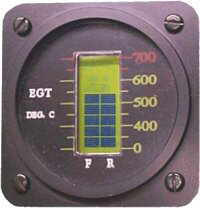
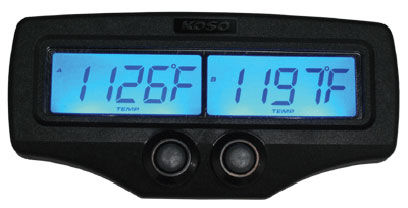
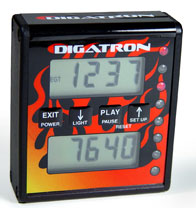
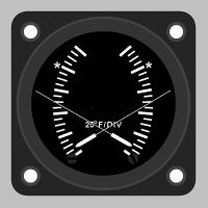
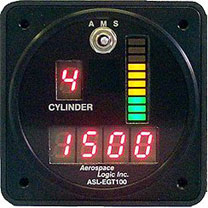
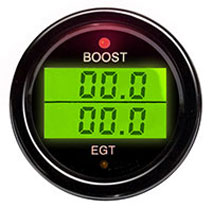
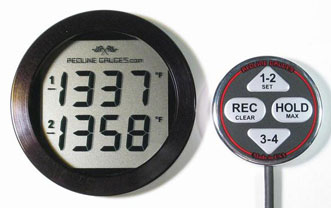
There are lots of dual egt gauges out there. None of them seem to have been designed by racers. If you want both Celsius and Fahrenheit you are out of luck. If you want high recall memory you might get it, but probably not. If you want a 3 bar boost display and dual egts, you certainly are not going to get it. If you want it visible day and night you probably won't find it. If you want a round or square gauge then you're all set.
If you want a compact billet dash that fits anything, has memory, visibility in day or night, dual egt functions, high recall, and is Celsius and Fahrenheit switchable, then it narrows down considerably. If you want a gauge that was designed from the start to have a simple, elegant, interface and one that that is useful in a stressful environment, i.e. actual competition, then the choice is pretty clear.
Details

1. The ORCA Turbo Dash uses three sensor inputs: Two type K thermocouples and a 3 Bar map sensor. The 3 Bar map sensor is external, powered by the display and not in the billet housing. This allows the map sensor to be remoted next to the engine. The map sensor must be located no further than 18" from the vacuum/boost port and elevated higher than it to prevent moisture condensation in the vacuum/boost line. Those issues we addressed 15 years ago. We provide the vacuum hose and a brass "T" to intercept this signal.
2. The hard anodized billet enclosure is water resistant but not 100% waterproof. It can be mounted externally but is not meant to be submerged in water. It is only 6.5" wide and 2.5" tall.
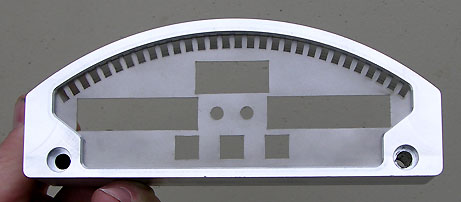
3. There are two four digit egt displays that read up to 1999 deg F or Celsius. Beneath the 30 led display is a 0-3 Bar three digit display (0.00 to 3.00). Digits are yellow and the "C" or "F" (5th digit) is green.
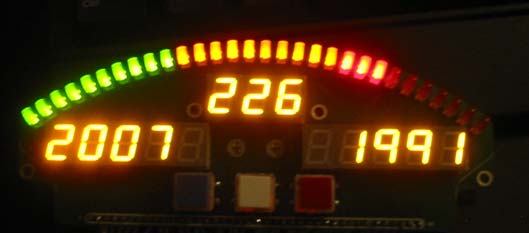
The 30 leds are left to right, 10 green, 10 orange and 10 red, representing one, two and three bar pressure ranges. The face plate is laser cut stainless steel, with an anti-reflection coated surface. Here pre-production operational code is being tested.
4. The buttons are both single and multi-functional. Blue is high recall. White is dimming function for nightime use. Red is to reset the display or to clear high recall. Pushing the Blue and Red buttons at the same time switches the display from Celsius to Fahrenheit.
5. The display has two 12V event lights, one red and one blue. The Blue light is a 12V input, typically indicating water injection has initiated. The red light has two inputs: 12V and ground. It is typically used to indicate low oil pressure.
6. A total of 12 wires exit the enclosure. Four for the two type K thermocouples. One 12V power input. One main ground wire. Three wires for the 3 bar map sensor. Three wires for the two event lights.
7. Two 1/4" socket head cap screws hold the dash body and back together and provide a rear point for mounting the unit. The orientation should be direct line of sight i.e. pivoted to point directly at your eyes.
Why EGT and Not Wideband for Turbos
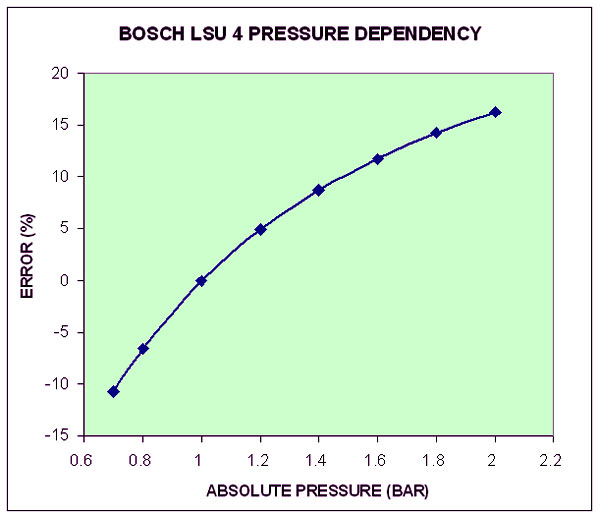
As you can see from the chart a Bosch LSU 4 wideband sensor has a 15% error if subjected to 2 Bar exhaust pressure. On turbos you have to mount a wideband sensor after the turbo which is a big problem because turbos, at least in race applications, use short dump tubes and this is way too close to oxygen-rich atmospheric air. On our race bikes we use our RSR Air Fuel Ratio Gauge which is not affected by exhaust pressure. On our Bonneville Bullett we run two single wire high temperature Bosch O2 sensors in addition to the dual egt ORCA Turbo Dash. Wideband LSU 4 sensors can be damaged with egts greater than 1500 Deg F. We run above this.
A second reason you use egt on turbos is that, if you are running race gas, any O2 sensor, narrow or wideband, will become contaminated, resulting in false readings. This can happen very quickly or maybe 10 hours later depending on the fuel used. When fouled, they render false lean readings. It is better to watch and record high egt temperatures which are completely unaffected by either pressure or racing fuels.
Deciphering EGT Measurements
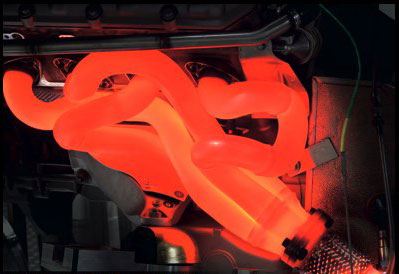
Temperature measurement is basically a can of worms. Heat is power but too much heat is destruction. Peak temperatures under load will occur at air fuel ratios near stoichiometry...say 14.7 to 15.0:1. Maximum torque occurs at air fuel ratios of around 13.2:1. The richer you run, up to a point, the lower your egts will be. The piston engine aero market has long looked at egts for both takeoff and cruise settings. They might see 1525 to 1550 Deg F for peak power and then back off to 1425 Deg F. These are safe numbers.
Aluminum starts to lose it's strength around 1100 Deg F and you can melt it at around 1400 Deg F...So why don't pistons melt? Well, the combustion process is never complete and there remains an unburned boundary layer of air-fuel mixture insulating the metal components of the combustion chamber from the flame front. This boundary layer is in thermal contact with the "cooler" metal whose surface temperature is well below the ignition temperature of the fuel/air mixture and does not burn when the flame front passes over it. This boundary layer is roughly the same temperature as the metal below and acts as an insulating layer preventing direct contact of the metal to the flame.
As to what the temperature should be depends on the fuel, the power requirements and the load. As we stated, the highest egts do not occur at maximum power air fuel ratios, which people generally target, that are slightly rich, in the 12.5:1 range. Some automotive manufacturers will radically drop the egts in their programming by dumping abnormally rich mixtures, perhaps 10.0:1, typically in supercharged vehicles, to prevent warranty meltdowns.
Basically, you are looking for abnormally high readings greater than 1650 Deg F which, if sustained, will likely result in piston damage.
The placement of the egt probes is a major issue.A general rule is that they must be uniformly located about 2" from the exhaust port. The further you get away the more the temperature drop. Bends in the exhaust will cost energy and drop the temperatures. Temperature drops result in speed losses. Header wrap is not recommended as it causes premature header failure. Ceramic coatings (exterior) are recommended.
In your combustion chamber the temperatures will be all over the map, greater than 2000 Deg F in localized regions, which is why this whole temperature measurement is, at best, something that you should monitor. In drag racing we want to nearly melt everything and flirt with 1800 Deg F for brief moments where the pistons are about to melt. Purple balls of melted aluminum on the spark plug. At Bonneville we may want to hold temperatures at 1450 Deg F, run leaner mixtures and use water injection.
In any case, you need to monitor your egts if you have a supercharger or a turbocharger. Turbochargers put all that exhaust heat back to work which is why compound turbos are employed.
Bonneville Bullett
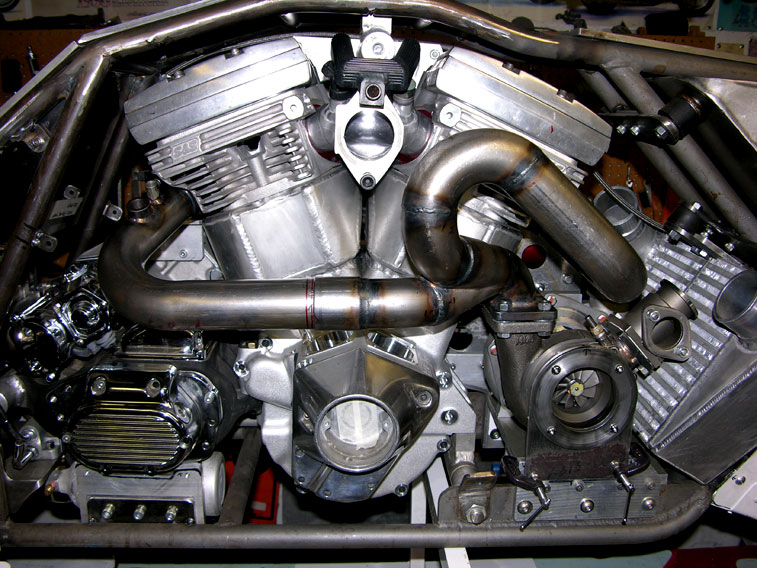
In case you are wondering what were run these on, here's a 139" watercooled ORCA motor we are taking to Bonneville. We put the first street bikes over 200 mph at both the Bonneville Salt Flats and El Mirage Dry Lake events more than 15 years ago. This new bike is pushing ancient pushrod technology to a new level. To see what we are up to, check out the Bonneville Bullett's progress. Dual O2 ports as well as dual egt ports.
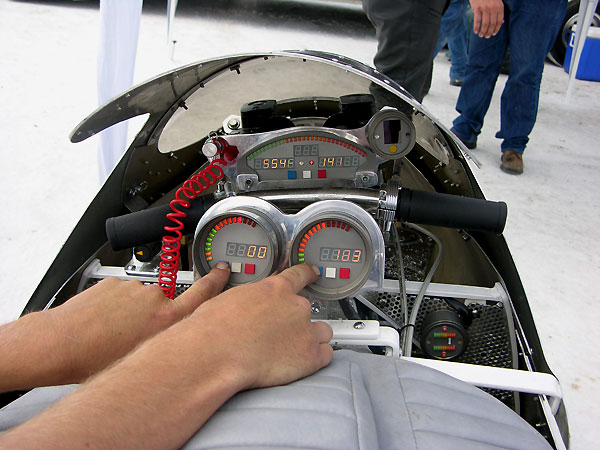
Here on Mike Geokan's Bullett at Bonneville to the left is the Orca digital tachometer and to the right is the Orca GPS Speedometer. Flicker rates on the seven segment displays don't show all the digits but blue memory recall button showed the results.
Digital Cameras don't pick up the flickering refresh rate of seven segment L.E.D.s...So here's the numbers: Bryan hit a peak of 6800 rpm somewhere during the 2 mile run, hitting a peak speed of 183 mph. The Orca Turbo Dash showed 1554 Deg F in the front cylinder, 1419 Deg F in the rear cylinder and a peak manifold pressure of 1.65 Bar (9.75 PSI Boost). He dropped the bike into 4th gear and his exit trap speed was 176mph. Bryan says he gave the bike too much throttle in 4th and it broke loose so he backed out.
The GPS Speedo was one L.E.D. short of 200 mph. Just after the last orange light is the 1st red light which is exactly, triangulated by four satellites, 200 mph. The digital Gear Position Display is to the upper right.
Long History
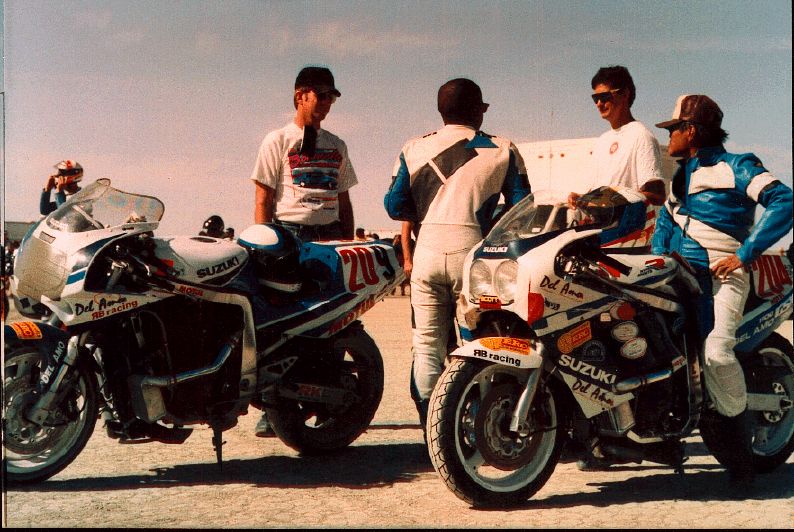
In the early 90's we tried to run EGT gauges on our 200 mph Suzukis. The vibration killed them. Their 180 degree flat plane cranks spinning at 11,000 rpm was a wonderful way to kill pyrometers designed for automobiles. We tried the same thing on our record setting BMWs and the gauges proved useless. Way before that in 1979-1985 we wrestled with EGT gauges on our turbocharged Harley-Davidsons. We finally gave up on them. Harleys kill anything.
About the only time we ever successfully used commercial pyrometers was on Jerry Branch's Superflow dynamometer where we measured temperature drops in BMW turbo header designs. Indoors, brief test, no outside factors to deal with.
Wouda, coulda, shoulda. We should have made our own gauges but we didn't and for the next 15 years we started and stopped a number of designs but, for one reason or another, they never went into production. Most were round designs, some with warning signals or lights that flashed...none ever saw the light of day. Many wasted hours.
Mozart could do it without false starts. We can't.
Object of Desire
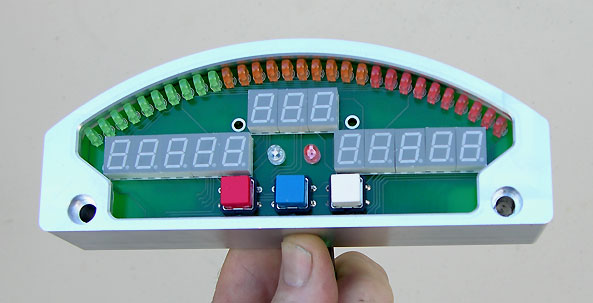
Now, 15 years later, or 35 years later, depending on how long ago you start the clock, we finally put something into production. What's the difference? Well, we are older and have been around long enough to know what works and what doesn't and what we need to do the job. Then there are the little items like $25,000.00 worth of design software, $100,000.00 machining centers, support machinery, many computers, and lots of obligations. Time.
Then there are the thousands upon thousands of hours doing what we do...building speed equipment. It sort of came to a head.
Final Form
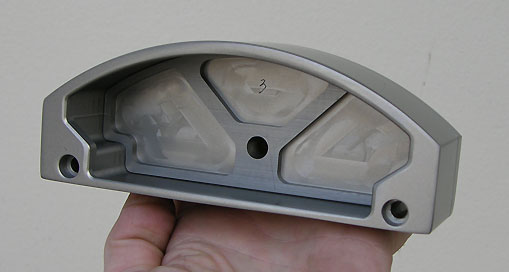
Hard anodized billet enclosure that we machine out of 6061-T6 aluminum. No flimsy plastic that would barely qualify as a consumer product. These are designed to withstand the rigors of both competition as well as the elements.

Blue, White, and Red is the final sequence on the buttons. Blue: high recall. White: dimming function. Red: reset or clear high recall. Push blue and red simultaneously and the display switches from Fahrenheit to Celsius indicated by a green "C" or "F" digit. Shown here in bright sunlight running at 2.64 Bar (24 psi).
Make Your Own Mount
These gauges are going on motorcycles, cars, boats, ultralights, diesels, to Bonneville, on drag racers, customs and street vehicles. In that we have no idea of what they are going to be used on we are going to let you figure out how to mount them.
To make your task easier we supply the Orca Turbo Dash with two sets of allen bolts. One set (2 bolts) is shorter and is flush with the captured nuts on the back of the display. The longer set allows the bolts to extend beyond the captured nuts and provides two points to attach a bracket or bolt the dash directly to a flat surface.
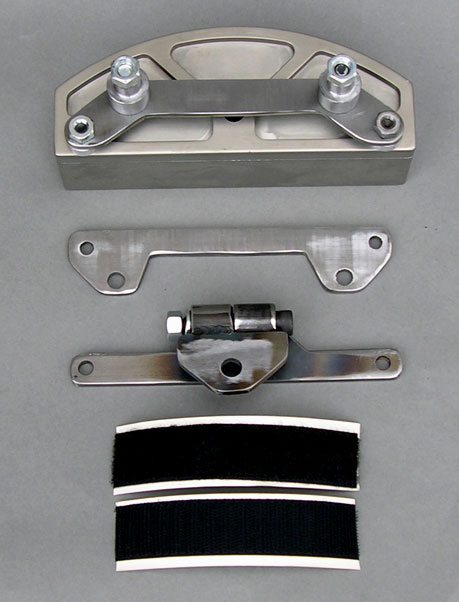
Here are three sample brackets we fabbed up using 3/16 x 1" cold rolled steel strap. One is for a BMW R1100RT Turbo, one for a 1999 Harley FXR Turbo, and one that pivots and bolts to a flat surface. Also pictured are two strips of velcro that can be used on a dash. We learned after about 30 years of fabricating things that it is not a good idea to invest time and money into brackets. No one likes what you do and everything is different. Everyone likes what they do. Easy decision.
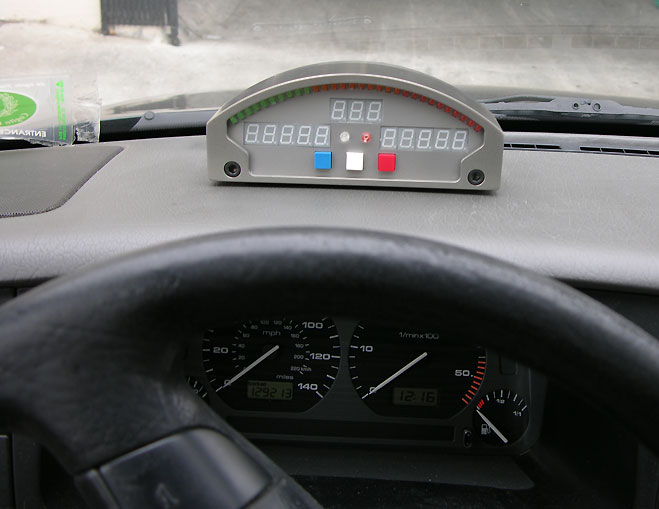
There are an infinite variety of locations for the Orca Turbo Dash. Roll your own mounting system. Pictured is a Jetta TDi Turbo Diesel monitoring egt and charge temperature, a perfect application as they do not come with a boost gauge or an egt gauge. Put in chips, larger nozzles etc. and you need to monitor things. You don't want to push a diesel past about 1300 Deg. Fahrenheit or 704 Deg. Celsius under fullload operation. Velcro mount to top of dash.
Know Your Limit

We are also experienced enough to have our designs reviewed and upgraded by people smarter than us when it comes to the latest microprocessors. We called on a consultant, Steve Manley, a graduate EE who has worked with us on other projects and asked him if he could do something better than we had drawn up. We were close to production, but after so much time and so many false starts, we needed someone to take a fresh look at the guts, not the design or the function.
Steve Manley..Racer / EE
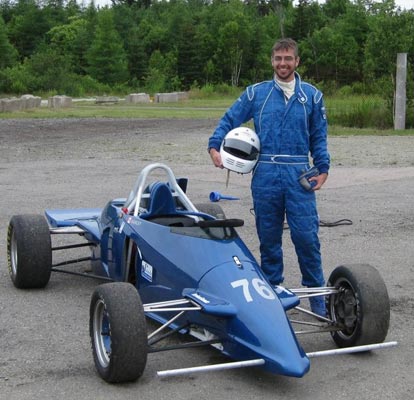
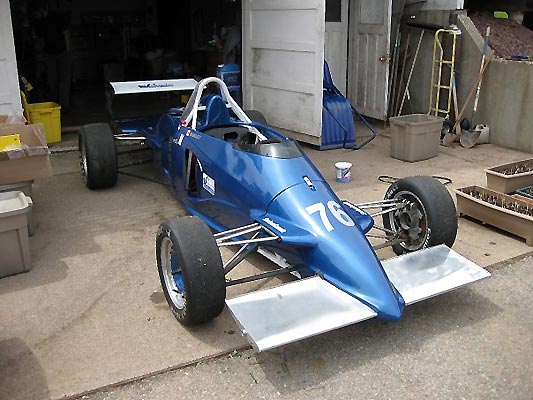
While we know what we want, we also know when to get help in electronics and embedded system design. Steve Manley, the principal of xdesignlabs, has spent way too much time fooling with digital tachometers and race car engineering issues, in-between flying around serving his growing base of racing and industrial clients... So we mixed our special requirements with his expertise and came up with the Orca Turbo Dash. We did the final circuit layout work, machining and mechanical design and Steve provided the circuitry and embedded code.
It takes a racer to understand racing. We race on two wheels and he races on four. The requirements are different but the ideas are the same.
In Canada all open wheeled race cars are required to have snow plows. Steve did a complete ground-up rebuild of this Reynard. You can view the process on his website.
Steve took our design and redid the circuits, making them less complex or more complex depending on your perspective. He freed up space by designing a second daughter circuit board as opposed to our jam-packed single board design. He went to dual microprocessors and rewrote the code to our display criteria. Even he had some false starts.
We've been down this road before and generally shoot electronic consultants on sight which is why we do design and layout work in-house. They either spin out of control and don't finish their work or fall in love with your designs and try to peddle them elsewhere. Steve is fun to work with and is a racer and has some appreciation of what we go through. Products are a bitch, we've been through the cycle hundreds of times in 30 years. It's never easy.
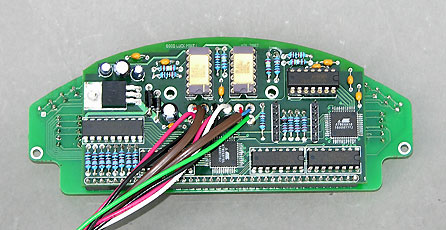
The part looks exactly the same as the one we designed but, beneath the hood, it was completely revised. Things change so quickly these days you just cannot keep up with all the advances yourself. If you deal in electronics you know how difficult it is to keep up with things. Piles of manuals and headaches ordering parts that are suddenly out of stock or obsolete. Steve came at it from a fresh standpoint and allowed it to be a more advanced product. Certain things we have a lot of experience with and those items stayed.
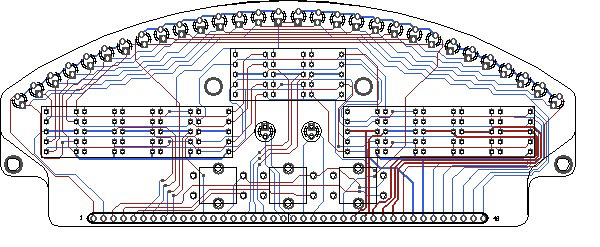
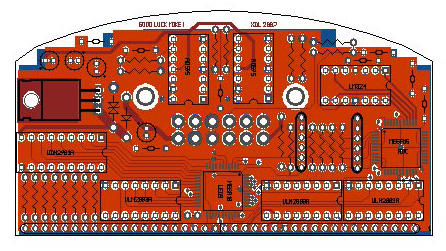
Maybe you are smarter when you you realize you aren't. Like in anything, the more you know, the more you realize you really don't know that much....and, as they say, "pregnant pauses" instead of absolute certainty dot the landscape as time goes by.
Testing
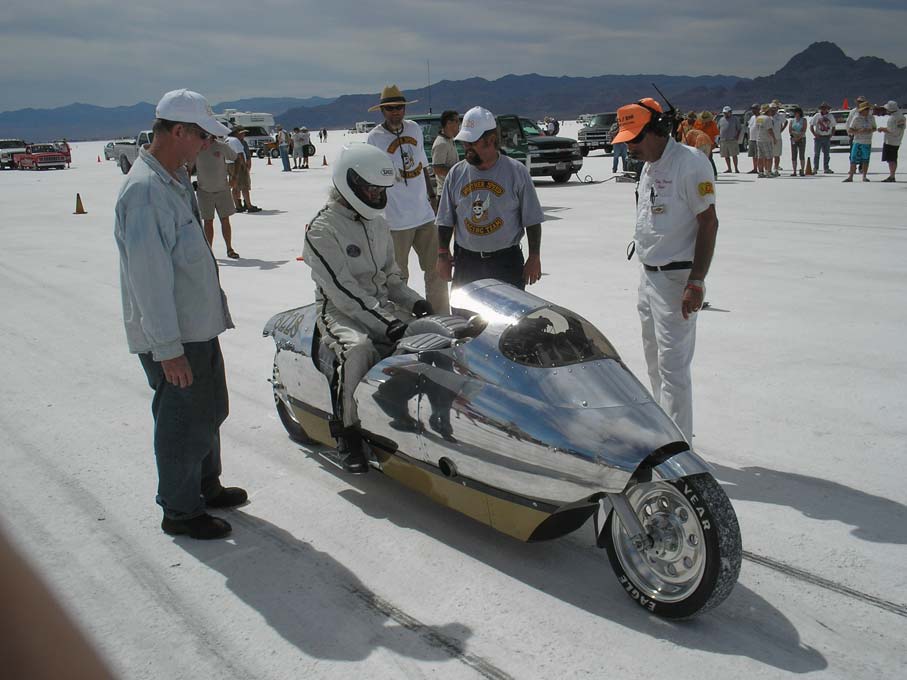
Testing is on-going and parts will be in production in early 2009. These dashes will be mandatory options on all of our BMW and Harley turbo kits. More movies will be posted of the dash in operation. In 2008 Mike Geokan was locked down on the lawyer-designed padding and headed for the floating mountain on his Bonneville Bullett, l.e.d.s transmitting data, Viet Nam era F4 Phantom aluminum on a mission. Pushrod clatter deafened by wind noise and adrenaline. Mike gave the bike to much gas and high-sided it, breaking his collar bone. We ran the bike down the course with an alternate rider on two test runs and held the bike at 3-5 psi, checking out the systems, showing 1300F on the front and rear cylinders. Read about it.
We don't do this for the money in case you haven't figured it out by now. The Orca Turbo Dash came about because we wanted it. Accountants would kill the project in a heartbeat...but they don't want to sit on a 250 mph motorcycle.
![]()